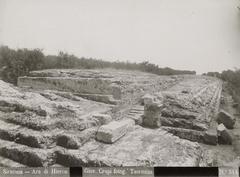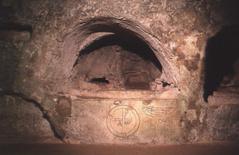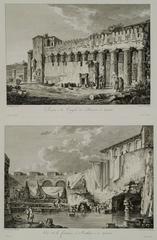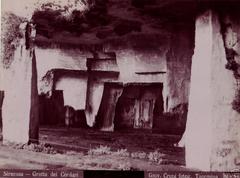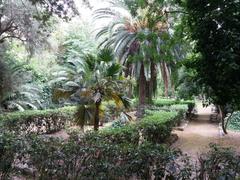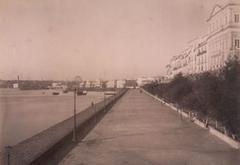Papyrus Museum Visiting Hours, Tickets, and Syracuse Historical Sites Guide
Date: 04/07/2025
Introduction: Discover the Papyrus Museum in Syracuse
In the heart of Syracuse, Sicily, the Papyrus Museum (Museo del Papiro Corrado Basile) stands as a singular tribute to one of Europe’s rarest botanical and cultural treasures: the papyrus plant. While papyrus is often associated with ancient Egypt, Syracuse is uniquely home to thriving natural papyrus groves along the Ciane River and Fonte Aretusa—the only location in Europe where papyrus grows abundantly. Since its founding in the late 20th century, the museum has become a hub for exploring the botanical, historical, and artisanal traditions of papyrus, offering an immersive experience that intertwines nature, culture, and history.
The museum’s exhibitions trace the journey of papyrus from its debated arrival in Sicily—possibly as a diplomatic gift from Egypt’s Pharaoh Ptolemy II to Syracuse’s ruler Hiero II in the 3rd century BCE—through its evolution into a versatile material for writing, crafts, and daily life. Here, visitors can view ancient papyri inscribed in Pharaonic, Greek, and Coptic scripts, observe live papyrus paper-making demonstrations, and learn about ongoing conservation efforts to protect this unique Mediterranean habitat. Located in the historic Sant’Agostino complex on Ortigia Island, the museum is easily accessible and central to Syracuse’s main attractions, making it a must-see for history enthusiasts, nature lovers, and cultural travelers.
For up-to-date visiting hours, ticket details, and upcoming events, consult the museum’s official resources. Embark on a journey into Sicily’s living heritage by visiting the Papyrus Museum. (citymapsicilia.it, italianbotanicalheritage.com, museodelpapiro.it)
Contents
- Syracuse’s Unique Botanical Treasure
- History and Development of Papyrus in Syracuse
- Botanical Significance and Habitat
- Traditional Uses and Cultural Importance
- Visiting Hours, Ticket Information & Location
- Exhibitions and Visitor Experience
- Educational Programs and Conservation
- Directions and Nearby Attractions
- Visitor Tips
- Frequently Asked Questions (FAQ)
- Challenges, Sustainability, and the Museum’s Future
- Summary and Key Takeaways
- Sources
Syracuse’s Unique Botanical Treasure: The Papyrus Museum
Syracuse is the only place in Europe where papyrus (Cyperus papyrus) grows naturally. The museum, together with the surrounding Ciane River and Fonte Aretusa, preserves this living heritage, providing insight into the plant’s historical, cultural, and ecological significance. The Papyrus Museum offers a captivating experience for all visitors, blending hands-on learning, tradition, and the natural beauty of Sicily.
History and Development of Papyrus in Syracuse
Papyrus has been integral to Syracuse since at least the 18th century, with historical records and travelers’ accounts documenting its local cultivation and use. Scholars suggest papyrus may have been introduced as a diplomatic gift in the 3rd century BCE, symbolizing ancient connections across the Mediterranean (citymapsicilia.it). Revived as a craft in the late 18th century by Saverio Landolina, papyrus paper-making became part of Syracuse’s artisanal heritage, a tradition still celebrated and preserved by the museum today (iheritage.eu).
Botanical Significance and Habitat
The papyrus groves of the Ciane River and Fonte Aretusa are ecological rarities, as they are the only such stands in Europe. The local variety, Cyperus papyrus siculus, forms lush green tunnels and habitats that are protected and studied by the museum and conservationists. These groves offer a living link to the ancient Mediterranean world and are a highlight for visitors interested in nature and biodiversity (italianbotanicalheritage.com, iheritage.eu).
Traditional Uses and Cultural Importance
Papyrus was historically used in Syracuse not only for writing but also for making ropes, mats, baskets, sandals, and boats. Its versatile fibers were employed in both daily life and religious festivities, with the process of papyrus paper-making—stripping, soaking, and pressing stems—demonstrated at the museum. Visitors can experience these traditions first-hand through workshops and live demonstrations (citymapsicilia.it).
Visiting Hours, Ticket Information & Location
- Location: Via Nizza 14, Sant’Agostino complex, Ortigia Island, Syracuse (italianbotanicalheritage.com)
- Opening Hours:
- October–April: Tuesday to Sunday, 9:30 AM–2:00 PM
- May–September: Tuesday to Saturday, 10:00 AM–7:00 PM; Sundays and holidays, 10:30 AM–2:00 PM
- Closed Mondays, December 25, January 1
- Tickets:
- Adult: €8
- Reduced (students, seniors): €5
- Children under 12: Free
- Family and group rates available
- Tickets can be purchased at the entrance or online (museodelpapiro.it)
- Accessibility: The museum is wheelchair accessible and provides ramps, elevators, and assistance on request.
Exhibitions and Visitor Experience
The museum’s collection includes:
- Ancient papyri from Egypt and the Mediterranean with Pharaonic, Hieratic, Demotic, Greek, and Coptic scripts
- Artifacts such as papyrus boats, mats, ropes, and containers
- Botanical specimens from Africa, Israel, and Sicily
- Tools and materials for papyrus processing and writing
- Digital and photographic archives for research and interactive displays
Visitors can participate in live demonstrations of papyrus paper-making and join workshops or guided tours for deeper engagement (italianbotanicalheritage.com). Rotating exhibitions and partnerships with international institutions enrich the visitor experience with rare manuscripts and themed displays (Live the World).
Educational Programs and Conservation
The Papyrus Museum is a center for education and conservation, offering:
- School programs and hands-on labs
- University-level courses on papyrus history, conservation, and Egyptology
- Restoration projects in collaboration with Egyptian institutions
- Public events, family days, and lectures
The museum actively promotes the protection of papyrus habitats along the Ciane River and works to safeguard Mediterranean heritage (italianbotanicalheritage.com).
Directions and Nearby Attractions
- Getting There: Easily reached by foot, public transport, or car from Syracuse’s city center. Parking is available nearby but may be limited during peak seasons.
- Nearby Attractions:
- Ciane River and Fonte Aretusa papyrus groves (nature walks, photography)
- Angolo del Papiro Museum (additional demonstrations, green spaces) (enjoysicilia.it)
- Syracuse Cathedral, Temple of Apollo, Greek Theatre, Archaeological Park of Neapolis
Visitor Tips
- Allocate 1 to 1.5 hours for a complete visit
- Book guided tours in advance, especially in high season
- Participate in workshops for a hands-on experience
- Visit in spring or autumn for the best weather
- Photography (without flash) is allowed; tripods are not permitted
Frequently Asked Questions (FAQ)
Q: What are the Papyrus Museum’s opening hours?
A: October–April: Tuesday to Sunday, 9:30 AM–2:00 PM; May–September: Tuesday to Saturday, 10:00 AM–7:00 PM; Sundays and holidays, 10:30 AM–2:00 PM. Closed Mondays.
Q: How much do tickets cost?
A: Standard adult ticket is €8, reduced tickets €5, children under 12 free. Discounts for families and groups.
Q: Is the museum accessible for people with disabilities?
A: Yes, the museum is fully accessible with ramps, elevators, and assistance available.
Q: Are guided tours available?
A: Yes, guided tours and workshops are offered; advance booking is recommended.
Q: Are tickets available online?
A: Yes, tickets can be purchased on the museum’s official website.
Q: Can I buy papyrus crafts or souvenirs?
A: The museum shop offers authentic papyrus products and souvenirs.
Challenges, Sustainability, and the Museum’s Future
As a private institution, the Papyrus Museum faces financial and operational challenges, relying on ticket sales, donations, and grants. Fluctuating visitor numbers and limited public funding remain ongoing concerns, occasionally leading to controversial measures, such as the sale of papyrus fragments to support operations (iheritage.eu).
Sustainability Initiatives
- Environmental: The museum promotes papyrus habitat conservation but has room to expand its own sustainable operations.
- Cultural and Social: Through preservation, education, and outreach, the museum contributes to safeguarding Mediterranean heritage, though broader accessibility and expanded opening hours could further inclusivity.
- Institutional: The museum seeks to diversify funding, expand digital resources (including virtual tours and archives), and strengthen partnerships with educational and cultural organizations.
Future Prospects
- Enhance digital outreach and global access
- Develop new educational programs and collaborations
- Explore additional funding sources, such as EU grants and sponsorships
- Continue adapting to changing tourism and cultural trends
Summary and Key Takeaways
The Papyrus Museum “Corrado Basile” is Europe’s only institution devoted to the natural, cultural, and historical legacy of papyrus. It stands out for its unique collection of manuscripts and artifacts, living demonstration of ancient crafts, conservation initiatives, and educational programs. While challenges remain—particularly in funding and accessibility—the museum’s innovative approach and strategic focus on sustainability ensure its continued relevance as both a repository of the past and a resource for the future.
Plan your visit by reviewing current hours and ticket information, and consider combining your museum experience with nearby Syracuse attractions. Enhance your exploration using digital resources such as the Audiala app for guided tours and interactive content.
Sources and Further Reading
- Papyrus Museum Syracuse: Visiting Hours, Tickets & History of Syracuse’s Unique Botanical Treasure, 2025 (citymapsicilia.it)
- Museo del Papiro Corrado Basile Information, 2025 (italianbotanicalheritage.com)
- Papyrus Museum in Syracuse: Visiting Hours, Tickets, History & Research, 2025 (museodelpapiro.it)
- Museo del Papiro Visiting Hours, Tickets, and Guide to Syracuse Historical Sites, 2025 (Live the World)
- Papyrus Museum Syracuse: Visiting Hours, Tickets, and Future Prospects, 2025 (iheritage.eu)
